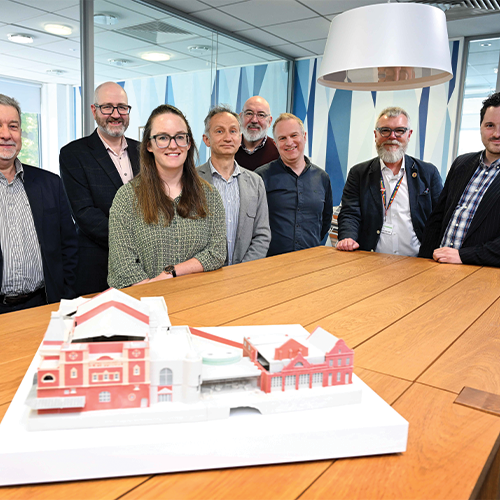Sebastian Messer, Senior Lecturer in Architecture at聽Northumbria University,聽writes about brutalist housing for The Conversation.
According to , a number of Britain鈥檚 brutalist council estates may be bound for the bulldozer. Some may celebrate the news: these estates 鈥渄esign-in鈥� crime; developers who ; or that they鈥檙e a nightmare to live in.
But there are two strong arguments to be made in defence of these buildings. Firstly, saving them from demolition preserves a period of our architectural heritage. Secondly, refurbishment offers a much more efficient way to create spacious, affordable housing.
Brutalist architecture arose in an era of social mobility, between the mid-1950s and early 1970s. Brutalism was an international style, but one which was supposed to be inflected with local characteristics. Like Art Nouveau half a century earlier, Brutalism took root in places trying to define a new sense of identity in the post-WWII world order 鈥� from the UK to Yugoslavia 鈥� and was exported as far as .
In the UK, brutalist buildings formed the backdrop to the of 鈥淪winging London鈥�. But it was also the architecture of a paternalistic culture: politicians, architects and planners who believed they knew what was good for the masses 鈥� domestically and culturally 鈥� and were entitled to decide this on their behalf.
Film director Stanley Kubrick captured this tension in his film . Filmed 鈥� replete with brutalist architecture 鈥� the setting was chosen to look futuristic, but also aspirational. As a mise en sc猫ne, Thamesmead represented an ordered society in contrast to the ultra-violence meted out in underpasses by the terrifying 鈥渄roogs鈥�.
These days, brutalist buildings embarrass us 鈥� they remind us of another period of European austerity, when we believed things actually could get better. They are bold, concrete memorials to the post-war political consensus: the provision of welfare and universal health care which aspired to provide spacious housing and secure tenure for all. No wonder that today鈥檚 politicians 鈥� determined to 鈥� say that something must be done about them.

Of course, that name really doesn鈥檛 help. 鈥淏rutalism鈥� is a poor Anglicisation of the French 鈥渂rut鈥�, meaning 鈥渞aw鈥�. The term had precedent in 鈥� referring to the paintings by psychiatric patients and children collected by Jean Dubuffet 鈥� and the term 鈥淏膿ton Brut鈥�, or 鈥渞aw concrete鈥�, which describes the rough, unfinished surfaces of concrete cast in-situ.
The idea was that brutalist buildings would be egalitarian. By exposing the nature of their construction with unpolished facades of raw concrete, the architects sought to elevate the ordinary and everyday to a form of art 鈥� which could be appreciated (occupied) by everyone. Of course, this approach was every bit as the architecture 鈥� before and since.
Putting up a fight

With such a rich history at stake, it鈥檚 not surprising that architects and academics Britain鈥檚 brutalist buildings. For example, architect defended the Robin Hood Gardens estate : 鈥淭hese buildings were not meant to be attractive: in a sense that is the whole point of them.鈥�
This is exactly the sort of statement which gives architects the reputation of being aloof and detached from reality. It generates : 鈥淚t鈥檚 all very well for architects to say that, they don鈥檛 have to live in them鈥�.
Yet this is a straw man argument. Given the right circumstances, people will choose to live in these buildings 鈥� and the key word here is 鈥渃hoose鈥�. Buildings such as the Unite d鈥橦abitation in Marseille, or are cases in point.
An appealing option
While the architects of the brutalist movement might not really have understood the needs of the communities they were trying to accommodate, they certainly did understand their own lifestyles. And this is still the lifestyle of the creative classes and the aspiration of many young professionals.

It is to refurbish the generously proportioned flats and maisonettes of council estates than to demolish them and to cart off millions of tonnes of concrete to landfill. It is also more sustainable, due to the and material resources that results from demolishing existing structures. Refurbished, apartments in council estates might well depress the sale price for new developments nearby, which would be a good thing for young people .
There is a in the UK, especially in the South-East. And it鈥檚 not going to be solved by , which sell primarily as investments and buy-to-lets. Refurbishing council estates offers an economically efficient way to ease this problem and preserve an integral part of our post-war history while we鈥檙e at it.
This article was originally published on . Read the .
News
- Northumbria graduate entrepreneur takes the AI industry by storm
- Study identifies attitudes towards personal data processing for national security
- Lifetime Brands brings student design concept to life
- New study reveals Arabia鈥檚 鈥榞reen past鈥� over the last 8 million years
- How evaluation can reform health and social care services
- Researchers embark on a project to further explore the experiences of children from military families
- Northumbria University's pioneering event series returns with insights on experiential and simulated learning
- Support for doctoral students to explore the experiences of women who have been in prison
- Funding boost to transform breastfeeding education and practice
- A new brand of coffee culture takes hold in the North East
- BBRSC awards £6m of funding for North East Bioscience Doctoral Students
- £3m funding to evaluate health and social care improvements
- Balfour Beatty apprentices graduate from Northumbria University
- Long COVID research team wins global award
- Northumbria researchers lead discussions at NIHR event on multiple and complex needs
- Healthcare training facility opens to support delivery of new T-level course
- Venice Biennale Fellowship
- Young people praise Northumbria University for delivery of HAF Plus pilot
- Nursing academics co-produce new play with Alphabetti Theatre
- Research project to explore the experiences of young people from military families
- Academy of Social Sciences welcomes two Northumbria Professors to its Fellowship
- Northumbria University set to host the Royal College of Nursings International Nursing Research Conference 2024
- 2.5m Award Funds Project To Encourage More People Into Health Research Careers
- Advice available for students ahead of A-level results day
- Teaching excellence recognised with two national awards
- Northumbria law student crowned first Apprentice of the Year for the region
- Northumbria University launches summer activities to support delivery of Holiday Activities and Food programme
- UK health leader receives honorary degree from Northumbria University
- Use of AI in diabetes education achieves national recognition
- Research animation explores first-hand experiences of receiving online support for eating disorders
- Careers event supports graduate employment opportunities
- Northumbria University announces £50m space skills, research and development centre set to transform the UK space industry
- The American Academy of Nursing honours Northumbria Professor with fellowship
- New report calls for more support for schools to improve health and wellbeing in children and young people
- AI experts explore the ethical use of video technology to support patients at risk of falls
- British Council Fellows selected from Northumbria University for Venice Biennale
- Prestigious nomination for Northumbria cyber security students
- Aspiring Architect wins prestigious industry awards
- Lottery funding announced to support mental health through creative education
- Early intervention can reduce food insecurity among military veterans
- Researching ethical review to support Responsible AI in Policing
- Northumbria named Best Design School at showcase New York Show
- North East universities working together
- Polar ice sheet melting records have toppled during the past decade
- Beyond Sustainability
- Brewing success: research reveals pandemic key learnings for future growth in craft beer industry
- City's universities among UK best
- Famous faces prepare to take to the stage to bring a research-based performance to life
- Insights into British and other immigrant sailors in the US Navy
- International appointment for law academic
- Lockdown hobby inspires award-winning business launch for Northumbria student
- Lasting tribute to Newcastle鈥檚 original feminist
- Outstanding service of Northumbria Professor recognised with international award
- Northumbria academics support teenagers to take the lead in wellbeing research
- Northumbria University becomes UK's first home of world-leading spectrometer
- Northumbria's Vice-Chancellor and Chief Executive to step down
- Out of this world experience for budding space scientists
- Northumbria engineering graduate named as one of the top 50 women in the industry
- Northumbria University signs up to sustainable fashion pledge
- Northumbria demonstrates commitment to mental health by joining Mental Health Charter Programme
- Virtual reality tool that helps people to assess household carbon emissions to go on display at COP26
- EXPERT COMMENT: Why thieves using e-scooters are targeting farms to steal £3,000 quad bikes, and what farmers can do to prevent it
- Exhibition of lecturer鈥檚 woodwork will help visitors reimagine Roman life along Hadrian鈥檚 Wall
- Students reimagine food economy at international Biodesign Challenge Summit
- Northumbria storms Blackboard Catalyst Awards
- Breaking news: Northumbria鈥檚 Spring/Summer Newspaper is here!
- UK鈥檚 first ever nursing degree apprentices graduate and join the frontline
- Massive decrease in fruit and vegetable intake reported by children receiving free school meals following lockdown
- Northumbria awards honorary degrees at University鈥檚 latest congregations
Latest News and Features

Innovate UK executives meet Northumbria RIBAJ Rising Star
On Thursday 22nd May, Innovate UK marked 50 years of Knowledge Transfer Partnerships (KTPs)…

International roll out of Northumbria learning scheme
A trailblazing education programme that has its origins in North East England is being rolled…

Northumbria retains globally-recognised built environment accreditation
Northumbria University has once again cemented its reputation as a leading institution providing…

Research programme boosts devolved cultural policy making
This week AHRC Creative Communities announced three major project outputs, with the creation…

Northumbria Professor appointed as REF sub-panel Deputy Chair
Northumbria University鈥檚 Professor Glyn Howatson will be playing a key role in the next national…

Northumbria University launches Centre for Responsible AI
Northumbria University has launched a pioneering centre of excellence in responsible AI research…

Annual showcase REVEALs next generation of creative and cultural talent
A student showcase which is one of the highlights of the North East鈥檚 cultural calendar is…

New research could enhance the future of teaching in higher education
Academics from universities across the UK are about to launch a research project which could…
Upcoming events

REVEAL: Theatre and Performance
Stage 2

Women鈥檚 Sport and Wellbeing Summit 2025
Lecture Theatre 003
-

NU Advice: Still time to apply
Virtual Event
-

